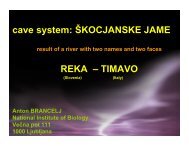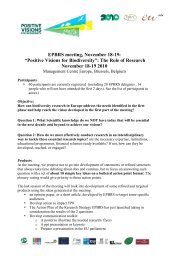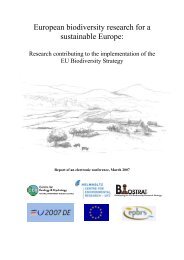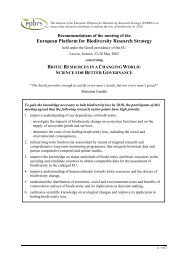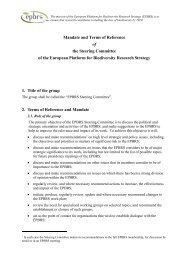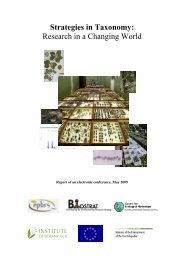Evaluation of the effectiveness of the New Instruments of ... - CORDIS
Evaluation of the effectiveness of the New Instruments of ... - CORDIS
Evaluation of the effectiveness of the New Instruments of ... - CORDIS
Create successful ePaper yourself
Turn your PDF publications into a flip-book with our unique Google optimized e-Paper software.
<strong>the</strong> proposal, which is generally considered as not reasonable in relation to <strong>the</strong> budgets<br />
concerned.<br />
On two statements, <strong>the</strong>re appears a significant difference in opinions among successful and<br />
unsuccessful proposers (where scores differ 0.4 points or more, marked in yellow) :<br />
• a majority <strong>of</strong> <strong>the</strong> unsuccessful proposers (54 %) confirm <strong>the</strong>y had to adapt <strong>the</strong><br />
research programme in order to fit with <strong>the</strong> work programme <strong>of</strong> FP6, whereas this<br />
proportion amounts only to 36 % <strong>of</strong> <strong>the</strong> successful proposers;<br />
• whereas 59 % <strong>of</strong> <strong>the</strong> successful proposers agree that <strong>the</strong> time foreseen by <strong>the</strong><br />
Commission between opening and closing date <strong>of</strong> a Call is realistic, only 40 % <strong>of</strong> <strong>the</strong><br />
unsuccessful proposers share this opinion.<br />
The fact that proposers are adapting <strong>the</strong>ir research programmes to fit <strong>the</strong> work programme <strong>of</strong><br />
FP6 is not necessarily negative. It can be a sign that <strong>the</strong> research programmes are more<br />
ambitious on <strong>the</strong> one hand, or it can be a sign that <strong>the</strong>y are making adaptations to maximise<br />
<strong>the</strong> chance <strong>of</strong> funding, even if <strong>the</strong> changes made are not necessary from a scientific point <strong>of</strong><br />
view. On this item again, <strong>the</strong> respondents are split into two groups. Those answering<br />
negatively (meaning <strong>the</strong>y did not adapt <strong>the</strong>ir research programme) is a group <strong>of</strong> 30 % <strong>of</strong> all<br />
respondents, <strong>the</strong> group answering positively is a group <strong>of</strong> 45 % <strong>of</strong> respondents.<br />
This adaptation <strong>of</strong> <strong>the</strong> work programme seems to happen:<br />
- more <strong>of</strong>ten for NoEs than for IPs;<br />
- more <strong>of</strong>ten for priority 3 and 6 than for o<strong>the</strong>r priorities.<br />
Table 3.5: Opinion on <strong>the</strong> added value <strong>of</strong> <strong>the</strong> application process (n=275) (on 5-points scale,<br />
whereby 5 = fully agree)<br />
Statement<br />
Successful<br />
n=130<br />
Unsuccessful<br />
n=145<br />
It is an unnecessary burden that reduces <strong>the</strong> time available to do 2.8 3.0<br />
research<br />
It helps in defining ambitious goals 3.6 3.4<br />
It forces us to find new partners and extend our networks 3.5 3.7<br />
It creates artificially large partnerships 3.2 3.7<br />
As <strong>the</strong> table shows, <strong>the</strong>re are no significant differences in opinion among successful and<br />
unsuccessful proposers where <strong>the</strong> added value <strong>of</strong> <strong>the</strong> application process is concerned. Both<br />
groups tend to agree that <strong>the</strong> application process helps in defining ambitious goals, finding<br />
new partners and extending <strong>the</strong>ir networks. However, a majority <strong>of</strong> <strong>the</strong> respondents (61 %) at<br />
<strong>the</strong> same time considers that <strong>the</strong> application process also creates artificially large<br />
partnerships.<br />
59



